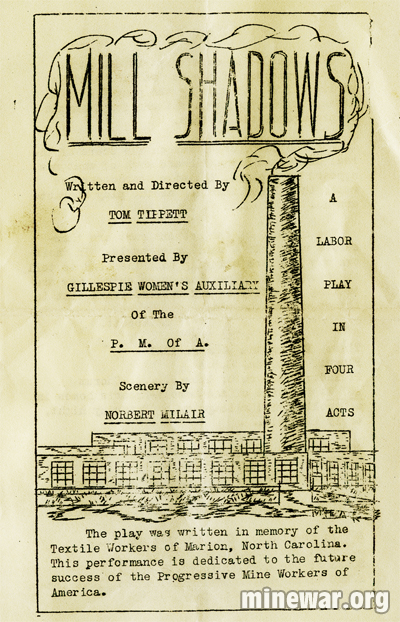Two views of the Staunton Labor Temple.The first was taken in the early 1930's and the other photograph was made this spring.
Nice to see a labor hub regarded as postcard-worthy in its day. At the same time, it's difficult to see that happening today.
Staunton was also the launching point for the Mulkeytown March. More on that here. You can also view the route of the march by clicking on the Google Mine War Map in the right column
Thanks again to Sean Burns for sharing the post card.
Monday, May 17, 2010
Yesterday and Today
Posted by
Make Better Media
at
5:36 PM
0
comments
![]()
Labels: Mulkeytown, Staunton
Wednesday, May 12, 2010
Mill Shadows: "Organize our strength as a working class."
Initially, an important part of the Progressive Miners’ program was to raise the class consciousness of its members and the broader community.
Tom Tippett, formally of the Brookwood Labor College was hired to head the PMA’s first Education Department. In a letter to the membership and auxiliaries Tippet wrote; “Our notion of an education activity is anything that will enable us better to organize our strength as a working class….We should like to set up classes in public speaking, in the writing and production of labot plays, in singing songs of labor, and we want to bring in outside speakers.”
Tippett was an author as well as an organizer and former miner. His play, Mill Shadows tells the story of workers who rebel and change their town from an industrial village to a union community. The play was directed by Tippett and cast by members of the Women’s Auxiliary.
Mill Shadows was performed in mining communities across Illinois with a final performance in St. Louis.

Thanks to Sean Burns for sharing this handbill.
In her memoirs housed at the University of Illinois at Springfield, Irene Allard describes how she was cast as “Granny” in the play:
I went to the Colonial Theater to try out and he [Tom Tippett] ignored me. He wouldn’t even let me read. And I was so unhappy when I went home I almost cried that he didn’t even let have a chance.
He chose a woman that the leading character in the Mill Shadows was a mountain woman. Sixty-five years old who walked with a cane and smoked a pipe…
Anyhow then Gerry [Allard] and I went to Chicago to ‘Free Mooney’ conference, convention. And we were gone about a week.
And when we came back I went right up to Tom’s office, “How’s Mill Shadows?” And he was a very dramatic person and he used his hands, you know.
And he starts pulling his hair, “It’s not going right. This woman that was to portray Granny, she couldn’t memorize the part. She hadn’t got beyond the first act. And we’ve got two weeks before opening night.”
So while he’s dramatizing there a little boy walked in, handed him a note and he read it and he turned to me and said, “Be at the theater at two o’clock.”
And I looked at him. I said, “What do you mean be at the theater at two o’clock.”
He says, “You’re Granny.”
And I said, “I’m not Granny.”
I said, “I wanted to be – (they had, one of the girls was named Irene.) I said, “I wanted to be Irene and you wouldn’t let me read for it. How can I be Granny?”
“You be at the theater at two o’clock.” Well, I was there at two o’clock and I became Granny. And that was one of the fun times in my life because it was something I never dreamed I could do.
Posted by
Make Better Media
at
8:35 AM
0
comments
![]()
Labels: Sean Burns, Tom Tippett, Women's Auxiliary


